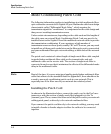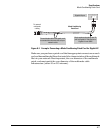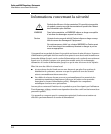
A-8
Specifications
Twisted-Pair Cable/Connector Pin-Outs
Twisted-Pair Cable/Connector Pin-Outs
The Auto-MDIX Feature: In the default configuration, “Auto”, the fixed 10/
100/1000Base-T ports on the 2520G-PoE switches all automatically detect the
type of port on the connected device and operate as either an MDI or
MDI-X port, whichever is appropriate. So for any connection, a straight-
through twisted-pair cable can be used—you no longer have to use crossover
cables, although crossover cables can also be used for any of the connections.
(The 10/100/1000-T ports support the IEEE 802.3ab standard, which includes
the “Auto-MDIX” feature.)
If you connect a 2520G-PoE switch twisted-pair port to another switch or hub,
which typically have MDI-X ports, the 2520G-PoE switch port automatically
operates as an MDI port. If you connect it to an end node, such as a server or
PC, which typically have MDI ports, the 2520G-PoE switch port operates as
an MDI-X port. In all cases, you can use standard straight-through cables or
crossover cables.
If you happen to use a correctly wired crossover cable, though, the switch will
still be able to automatically detect the MDI/MDI-X operation and link
correctly to the connected device.
Note Using Fixed Configurations. If the port configuration is changed to any of
the fixed configurations though, for example 100 Mbps/full duplex, the port
operates as MDI-X only and the correct cable type must be used: for
connections to MDI ports, such as end nodes, use a straight-through cable; for
connections to MDI-X ports, such as on hubs and other switches, use a
crossover cable.
Other Wiring Rules:
■ All twisted-pair wires used for 10 Mbps, and 100 Mbps operation must be
twisted through the entire length of the cable. The wiring sequence must
conform to EIA/TIA 568-B (not USOC). See “Twisted-Pair Cable Pin
Assignments” later in this appendix for a listing of the signals used on each
pin.
■ For 1000Base-T connections, all four pairs of wires in the cable must be
available for data transmission.
■ For 10 Mbps connections to the ports, you can use Category 3, 4, or 5
unshielded twisted-pair cable, as supported by the IEEE 802.3 Type
10Base-T standard.


















